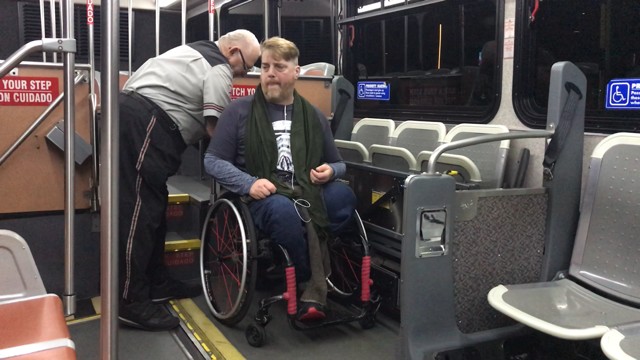KJIPUKTUK (Halifax) – In 1994, shortly after a two-year hospital recovery from an injury, I went on a West Coast tour with a band I played in at that time. While in Victoria I saw a city bus with the “blue guy/accessible” symbol. Being new at living with disabilities, I had many questions, and since the bus was empty the driver had a few minutes to talk.

He lowered the bus on its hydraulics, deployed the ramp, and brought me on board to show me how the bus made it possible for someone in a wheelchair to ride safely. He hooked me in with four straps that held my chair still, and put on a shoulder/lap belt to hold me in the chair. I was relieved to learn that there was a way to ride a city bus for me.
I moved back to Halifax in 2001. Accessible cabs were appearing about six years ago, but have never been a reliable way to get around for someone in a wheelchair. There aren’t enough of them, and the companies are unable to schedule drivers when you need them.
That’s why despite bus stops not always being accessible, the bus became my mode of transportation of choice. I started taking the bus to get to my photo studio down on Barrington Street. The first kneeling buses Halifax Transit bought were the older single-length buses. They had reinforced plywood floors that were great to put the anchor points in for the four strap system and the lap/shoulder belt system.
Then Transit started buying the double-length buses, and things became more complicated for us wheelchair users.
The floors are not reinforced, so the anchor points cannot be put into the floor, which is why these buses use a “one strap” system. Facing backwards on the bus, the driver hooks a seat belt onto the back of my chair somewhere. Though my chair has great brakes, the fact is brakes are made to hold someone in place in a non-moving scenario, not on a bus that is making tight turns and making quick stops/starts. The chair still moves laterally(front casters are non lockable) and has enough play to go as many as two feet from where it comes out of the wall behind my chair. And there is no lap/shoulder belt.
When someone is in a wheelchair, generally they have an issue with leg strength, so where an able-bodied person is able to starfish’ and stop themselves from falling out of their seat on the bus, for me it requires applying the old sailing slogan of three points of contact, which for me is my butt, and two hands usually. On one side of the bus is a straphanger strap I can grab, but I still need to hook my arm through the back of the folded seat next to me to keep from falling out of my chair at stops, starts, and turns. It’s exhausting to ride in fear for my safety each time I need to use the bus.
A year and a half ago I wrote to Halifax Transit to ask what they were going to do about the tie down issue. They wrote back to tell me about this new mechanical system called the Quantum Securement System. They were going to do a pilot project with it, on the #7 bus, later in the year, but would I like to be the first to give it a test drive?
I very happily and excitedly got on a transit bus at Scotia Square a year ago from last November. There were reps from many departments.The system worked like a charm. The wheelchair rider deploys the mechanical arm themselves, so the driver doesn’t need to come tie them down. There was no lap or shoulder belt installed, so while my chair was held completely immobile by the Quantum, I still had to find handholds.
Through Director of Transit Dave Reage I found out that the total cost of the Quantum Securement System, two units per bus over three hundred or so buses, was going to cost us about $20,000,000. That’s a lot of money, and may well be why, after the pilot period ended, I was informed by Mr Reage that Transit was not going with the Quantum Securement System. He said that they were looking at something else, and was sent a link to something produced by the same company called the Q Pod. Would I help with the evaluation?
Of course I said yes.
Fast forward to early February and I am in Disney World for a one week vacation. Every shuttle bus in the parks had the Q Pod installed. For that week I used the Q Pod system two to four times a day.
There is no need for in-floor tie downs through a nice minimal setup that takes up no more room than the current one-strap system we now have here in Halifax. Instead of a four point tie down there are two straps attached to hardpoints on the back of the chair and a diagonal strap on a tightening handle to lock the front. There is also a small bumper to place the chair in the perfect position, that also helps immobilize the rider more securely.
For the week I collected video and still photos, and interviewed drivers and riders. One of the buses I was on had over a million miles on it, and the Q Pod had worked without major breakdown the entire time.
Historically, and this is not unique to Halifax, governments tend to do things for the disabled community, without close consultation, which tends not to work out so great. In the last few years we have seen improvements, especially in City Hall and Public Works, and Winter Operations. Transit had been a bit of a holdout, but I am happy to see that change now, and am grateful for being granted a voice to advocate for the needs of my community.
Halifax Transit made an announcement last year about having 100% accessible buses, but this refers to kneeling buses with a deployable ramp. It doesn’t address the need for a safe, effective and affordable tie down system. Hopefully with the Q Pod, or something similar, we can finally take care of this for once and for all.
Paul Vienneau is a Halifax photographer, inclusivity activist and disablilty advocate.
If you can, please support the Nova Scotia Advocate so that it can continue to cover issues such as poverty, racism, exclusion, workers’ rights and the environment in Nova Scotia. A paywall is not an option, since it would exclude many readers who don’t have any disposable income at all. We rely entirely on one-time donations and a tiny but mighty group of dedicated monthly sustainers.




I was in a chair for 4 months before recovery to a walker. Until you’ve lived in one you have no empathy.